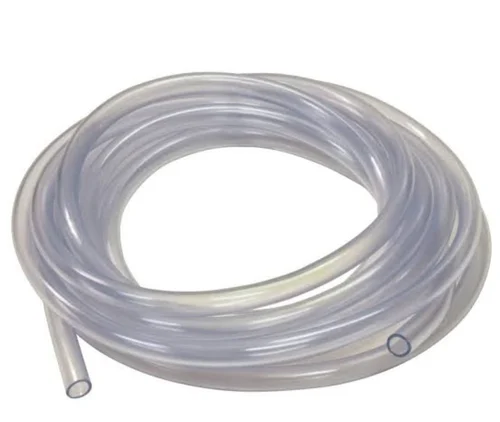Understanding Medical Grade Tube: Composition & Benefits
Medical Grade Tubing Materials
There are many different types of medical-grade tubing, each with unique qualities for specific applications. Below is a summary of several popular options:
- Silicone: Known for its exceptional flexibility and biocompatibility, silicone tubing is very effective in respiratory, feeding tube, and catheter applications. Its resilience to chemicals, heat, and cold makes it a flexible option.
- Polyvinyl Chloride (PVC): An affordable and frequently used option for IV tubing, drainage tubes, and blood bags. DEHP-free formulations are preferred to reduce possible leaching.
- Polyurethane (PU): This biocompatible and long-lasting substance excels in wound drainage systems, vascular access devices, and catheters. Its flexibility is ideal for situations requiring dexterity.
- Thermoplastic Elastomers (TPE): Combining the processability of plastic with the elasticity of rubber, TPE offers an alternative to latex. This makes it a great choice for anesthetic circuits, IV setups, and other medical tubing requirements.
Key Characteristics of Medical Grade Tubing
Beyond safety, medical grade tube has other essential qualities for peak performance in healthcare environments:
- Biocompatibility: Ensures the tubing won’t react negatively when it comes into contact with human tissue.
- Sterility: Produced and packed in controlled environments to ensure sterility and avoid infections during procedures.
- Flexibility: These tubes bend and flex without kinking or cracking, essential for moving within the body or around medical equipment.
- Chemical Resistance: Resistant to body fluids, disinfectants, and pharmaceuticals, preserving its integrity for dependable operation.
- Transparency: Clear tubing allows for visible fluid examination and detection of possible obstructions, ensuring prompt intervention when necessary.
- Radiopacity: Shows up under X-ray, facilitating accurate monitoring and placement during medical treatments.
Applications of Medical Grade Tubing
These tubing are essential to many healthcare applications, forming a network inside medical equipment that enables the delivery of crucial gases and fluids and supports various operations:
- Intravenous (IV) tubing: Supplies nourishment, medicines, and fluids directly into the bloodstream.
- Catheters: Facilitates the insertion of tiny tubes for drainage, medicine administration, and other treatments. Used for urine or central venous catheters.
- Feeding tubes: Provides essential nutritional support for patients unable to eat normally.
- Breathing tubing: Delivers oxygen and other breathing gases to those in need.
- Surgical Drains: Helps manage fluid and blood drainage post-surgery to aid in healing and prevent complications.
- Wound Drainage Systems: Efficiently drains fluids from chronic wounds to promote optimal healing.
- Blood Bags: Ensures safe storage and transportation of blood for transfusions.
- Dialysis Tubing: Essential for removing waste from a patient’s blood during dialysis treatments.
Standards and Regulations for Medical Grade Tubing
Medical-grade tubing adheres to strict standards and regulations to ensure patient safety and device functionality:
- ISO 10993: Establishes the basis for assessing the biocompatibility of medical devices, ensuring tubing minimizes adverse tissue responses.
- United States Pharmacopeia (USP) Class VI: Thoroughly examines the biological reactivity of polymers used in medical equipment, such as tubing.
- FDA rules: In the United States, the Food and Drug Administration (FDA) enforces rules that guarantee the safety, effectiveness, and quality of these vital components.
Manufacturing Process of Medical Grade Tubing
Medical grade tubing undergoes a rigorous production process to ensure accuracy and safety. Here are the two primary techniques:
- Extrusion: The most common technique, extrusion involves melting raw material and passing it through a die with a specific shape, producing tubes with uniform dimensions and profiles.
- Molding: Used for complex components or shapes. The final tube component is formed by injecting molten material into a precisely shaped mold and cooling it down.
Quality Control Measures for Medical Grade Tubing
Strict quality control measures ensure the integrity and functionality of medical grade tubes:
- Visual Inspection: Skilled staff carefully inspect tubes for flaws such as bubbles, fractures, or discoloration.
- Dimensional Checks: Accurate measurements ensure that the tubing complies with size and tolerance specifications essential for optimal performance.
- Leak Testing: Identifies any weak spots in sealed connections to prevent potential fluid leaks during operation.
- Biocompatibility Testing: Ensures that the materials used in the tubing won’t cause adverse reactions when in contact with the body.
Packaging for Medical Grade Tubing
Sterilized packaging ensures cleanliness and prevents contamination during storage and transportation. Proper handling and traceability are facilitated by clear labels that provide information about the product, lot number, expiration date, and sterilization process.
Emerging Trends in Medical Grade Tubing
The future of medical grade tubing holds many exciting possibilities. Here are a few key trends to watch:
- Advancements in Material Science: New materials promise improved flexibility, strength, and biocompatibility, leading to more effective and patient-friendly tubing.
- Smart Technology Integration: Sensors and indicators built into tubing could monitor patient health or detect integrity issues, promoting proactive treatment.
- 3D Printing: Allows for customization of tubes for individual patients or specific procedures, providing a more personalized approach to healthcare.Bioabsorbable Solutions: Materials that the body can naturally break down may reduce the need for additional removal surgeries, simplifying patient care.
